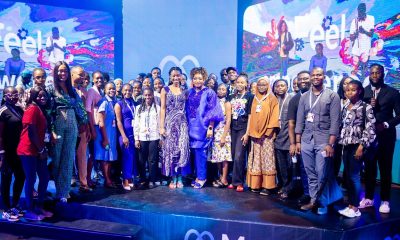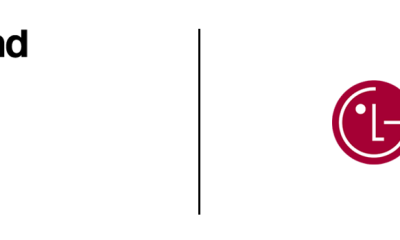Health
Crib A’Glow: Saving tiny hearts in the FCT through technology

Placed on a hospital cupboard about two meters from the ground, the little box glows with a brilliant blue light, beautiful in the dark. Unlike the normal incubator used in Paediatric Intensive Care Units (PICU), the box measures approximately about 1m x 0.5m x1m (3ft x 2ft x 2ft) and weighs a little above 5 kilograms (11 pounds) . This box has saved the lives of many babies since a young mother and her team first produced it, three years ago.
Originally conceived, designed, tested and launched in Yenagoa, Bayelsa State, the box now sits in the paediatric units of various hospitals in the Federal Capital Territory (FCT), including Maitama, Wuse and Asokoro District Hospitals.
Named Crib A’Glow, it is a low-cost phototherapy solution to treat newborn babies with neonatal jaundice. It was developed by a young mum and professional graphic designer, Virtue Oboro, after her son’s experience with jaundice. With a group of medical professionals and biomedical engineers, she built a prototype, but it took four failed attempts and several trials before the product worked and she started her company, Tiny Hearts Technologies.
Addressing a Silent Child Killer
Data from the World Health Organization’s Global Health Observatory shows that in 2017, newborn deaths accounted for 47% of deaths among children under five, and in 2016, 1 million children died as a result of complications arising from premature births. While jaundice occurs in about 50% of babies reaching full term, it occurs in 80% of preterm babies. A paediatric specialist at the Asokoro District Hospital in the FCT estimates that 8 out of every 10 premature births in their unit have the condition.
Image credit: Nigeria Health Watch
Jaundice is usually caused by an excessive build-up of bilirubin, a substance made when the body routinely breaks down red blood cells. However, a newborn’s still-developing liver often cannot remove bilirubin quickly enough, causing an excess. Another predisposing factor is Rhesus (Rh) incompatibility between a mother and her baby. Although a small number of babies have different rhesus blood types from their mothers, these mismatches can lead to jaundice. Occurring in the first few days of life, the most notable symptom is a yellow colouration of the skin, which with time, is also observed in the whites of the eyes. While many mild cases do not require treatment, the common treatment for severe jaundice is phototherapy which involves placing the baby under a special type of light that helps break down the excess bilirubin.
A harrowing experience with jaundice
If the bilirubin isn’t broken down quickly enough, it can lead to death or severe disability. Early detection is therefore very important because the symptoms can be missed by new mothers. In the case of Oboro, she thought her son, Tonbra, “just had a fair complexion.” Oboro was discharged from the hospital about 48 hours after delivery, and it wasn’t until her mum, a nurse, came visiting that she realised the yellowish colour was unusual. Once they returned to the hospital, little Tonbra was diagnosed with jaundice. Oboro described the experience that followed the diagnosis as “harrowing“, as the excitement of the birth of her first son was replaced with fear and uncertainty, especially when she learned of the possibility of brain damage if the diagnosis was not properly handled.
With all phototherapy treatment units in use at the PICU of the hospital where Tonbra was admitted, a mother whose baby had almost recovered asked that her baby be discharged to give baby Tonbra a chance. Almost immediately, he was placed inside the phototherapy unit, but then, there was a power outage and other alternative sources of power in the hospital failed. The doctors performed an emergency blood transfusion which sustained him until he was able to access a phototherapy unit. After about a week, Oboro returned home with her baby but the experience was not to leave her for weeks.

Nurses at Wuse General Hospital search for space to place the Crib A’Glow phototherapy unit. Photo source: Tiny Hearts
Necessity usually leads to invention but for Oboro, it was a combination of the near-death experience of her son, curiosity, a passion for problem-solving and empathy for other babies who might face similar situations, that led to the development of Crib A’Glow.
Once she and her son had recovered from the experience, she set out to learn more about jaundice and possible ways for other parents and healthcare providers to overcome the challenges they had faced. The main problems turned out to be lack of quick access to treatment and unstable power supply.
After extensive research, Oboro and her team came up with Crib A’Glow, a simple solar-powered phototherapy system that can be easily moved around to locations where it is needed.
Powered by the sun, the unit solves the problem of unreliable power supply. It also improves ease of access as the equipment can be easily disassembled and moved from one location to another where it is needed urgently.
As a social enterprise, the company is sustained by selling and hiring out the Crib A’Glow phototherapy units. A unit sells for N150,000 and can be rented at the rate of N3000 for 24 hours. Tiny Hearts Technologies also produces disposable phototherapy blindfolds, conducts training programs and recently launched a sensitisation initiative called Yellow Alert to help raise awareness about neonatal jaundice among pregnant women.
 Medical staff at the neonatal and pediatric unit in Asokoro District Hospital watch a demonstration of the Crib A’Glow phototherapy unit. Photo source: Tiny Hearts
Medical staff at the neonatal and pediatric unit in Asokoro District Hospital watch a demonstration of the Crib A’Glow phototherapy unit. Photo source: Tiny Hearts
Beyond Bayelsa: Scaling up a home-made solution
Since the inception of Tiny Heart Technologies in 2016, over 1250 babies have benefitted from their initiative, says Oboro. For her, the task of pitching their services to hospitals is a difficult process because most times, they are met with scepticism. “They usually prefer big equipment from big companies outside Nigeria and usually don’t want to try homemade solutions,” Oboro said. However, they continue inventing strategies to win them over. She recounted how such efforts saved a baby’s life and led to bringing the Crib A’Glow unit to three hospitals in the FCT.
In February 2018, Oboro walked into the paediatric intensive care unit of the Niger Delta University Teaching Hospital (NDUTH) in Yenagoa, Bayelsa state capital. Her mission was to retrieve the phototherapy unit she had rented to the hospital for use. An attending paediatrician told her that a baby was to start treatment with the unit, but the parents were unable to afford it. After hearing the story and with a plea from the doctor to assist, she decided to see the baby.
 Medical staff at Wuse General Hospital receive a free unit of the Crib A’Glow phototherapy equipment from Tiny hearts technologies. Photo source: Tiny Hearts
Medical staff at Wuse General Hospital receive a free unit of the Crib A’Glow phototherapy equipment from Tiny hearts technologies. Photo source: Tiny Hearts
Baby Ndukwe, as he was called, had jaundice but presented at the hospital when complications had set in. His parents had turned to herbal remedies when they first noticed he was sick. On seeing the state of the baby, Oboro decided to assist by starting a fundraiser for him even though it was out of their line of business. She got consent from the parents, took baby Ndukwe’s picture and asked for financial help through her WhatsApp network. Within 24 hours, over N70,000 was raised. This helped offset his medical bills, rent the phototherapy unit for the duration of his treatment and even covered the next baby in need of treatment.
Someone who donated to the fundraiser for baby Ndukwe bought three units of the phototherapy unit and anonymously donated them to three hospitals in Abuja. Oboro said the donor’s motivation was simple. “She said since the Crib A’Glow helped save the life of one baby, she wanted to extend that opportunity to other babies who might need it,” she said.

Twin babies placed inside a Crib A’Glow phototherapy unit in a private hospital in Bayelsa. Photo source: Tiny Hearts
Can Nigeria sustain innovative homegrown start ups?
The challenges with the Crib A’Glow solution are not different from other Nigerian start-ups and largely revolve around the cost of running a business, hiring and retaining talent, government support and regulations. But as a Nigerian medical equipment and device start-up, Tiny Hearts Technologies has its unique set of challenges too, one of which is the inherent preference for imported products. Oboro said this is one of their biggest challenges because it’s difficult to convince hospital executives to adopt their solution.
The cost of using the equipment is another challenge. Hospitals that rent the units need to make profit because they are running a business. This is likely to increase the cost for patients’ relatives and introduce a barrier to access. This can be overcome if there is an effective health insurance system that covers citizens in the formal and informal sectors.

The Crib A’Glow phototherapy unit was donated to Maitama District hospital by an anonymous donor after it saved a baby’s life in Bayelsa. Photo source: Tiny Hearts
A challenge which raises an important question is the issue of patents and protecting intellectual properties. How well are these innovations protected especially in a highly competitive market like Nigeria? Oboro says she has a patent right which offers protection for her design. The legal framework for patents is enshrined in the Patents and Designs Act of 1971. In place for nearly five decades now, is the Act still in tune with current realities, and able to protect young inventors?
Globally, there is a need for affordable technologies to tackle neonatal jaundice. The Crib A’Glow is one of such but for it to thrive, we must develop a culture of adopting and supporting Nigerian-made solutions once they are proven to be effective. The team has plans of expanding to other African countries but charity, they say, begins at home. Let us adopt and use our own, so that other babies like Tonbra and Ndukwe can be given a fighting chance.
By Chibuike Alagboso (Lead Writer)
Health
Inaugural Pan-African Nutrition and Health Summit set to shape a healthier continent

The inaugural edition of Africa’s Nutrition and Health Summit is set to convene on November 16, 2024, bringing together an extensive network of healthcare practitioners, nutrition experts, agricultural stakeholders, policymakers, and influential leaders from all over the continent under the theme, ” Soil to Wellness: Shaping a United Approach to Africa’s Health.” This groundbreaking summit aims to address the critical rise of non-communicable diseases (NCDs) across Africa through integrative approaches to preventive health, nutrition, and sustainable lifestyle practices.
This movement would explore holistic and practical solutions that unite stakeholders along the health and nutrition value chain, with a critical focus on how surging rates of NCDs like diabetes, hypertension, and obesity can be curbed via sustainable agriculture, improved food quality, and healthier lifestyle choices, to reshape our food and lifestyle culture, thereby laying a foundation for better health outcomes, for generations to come.
A Key Focus on Nutrition and Lifestyle Practices
The summit’s agenda will include panels on integrative approaches to nutrition and preventive health, the dual burdens of malnutrition and obesity, the impact of digital health in preventing diet-related diseases, and the role of sustainable agriculture in food quality. Our holistic approach strives to demonstrate how Africa’s diverse and rich agricultural resources can play a pivotal role in ensuring food security, balanced nutrition, and wellness for all citizens.
Call to Action
The inaugural edition of ANHS is especially relevant to anyone invested in the long-term health and wellness of the African continent. Such stakeholders are not limited to health professionals, nutrition experts, agricultural stakeholders, policy influencers, researchers, food producers, and processors. It is indeed a legacy-defining opening for businesses and community leaders interested in leaving their prints in the sands of policies that would advance health and wellness on the continent.
Participants will gain insights from leading experts and join the cause to champion Africa’s health by focusing on the most essential aspects of disease prevention and overall wellness. Now, more than ever, it is crucial to prioritize wellness at the societal level, addressing the connections between soil health, food quality, and sustainable practices that contribute directly or indirectly to healthy living.
Join us at the inaugural edition of Africa’s Nutrition and Health Summit on November 16, 2024, as we unite to shape a healthier continent – one that intentionally harnesses her resources and expertise to combat non-communicable diseases.
Register here to attend ANHS 2024
For more information, press inquiries, or partnership opportunities, please contact:
RSB
Official Branding Partner of ANHS
Health
Dr. Jesupelumi Adenihun: Adopting a lifestyle of sustainable health practices with food

Dr. Jesupelumi O. Adenihun (Image: Supplied)
You have likely heard the saying, “You are what you eat,” and it couldn’t be truer. What we consume plays a far greater role in our health than many of us realize. Over time, our eating habits can either support our body’s natural healing processes, leading to improved health and vitality, or contribute to nutrient deficiencies, inflammation, and even chronic diseases.
What this means is, our eating habits over time sets off a series of chain reactions in our bodies that impact our overall well-being. The good news, however, is that by consistently making the right food choices, we can put ourselves on the path to a state of good health and well-being. While this might sound daunting at first, it is often the small, consistent actions that yield the best results. Let’s take a look at 10 simple but effective habits you can begin to cultivate for better health and adopt as lifestyle practices:
- Substitute soda with water: No beverage is more refreshing or beneficial than plain water. It hydrates, cleanses, and confers numerous health benefits.
- Snack on nuts and seeds: When you are craving a snack, go for nuts or seeds, unless you have an allergy. They are nutrient-dense and can also be satisfying.
- Opt for grilled or baked over fried: Choosing grilled or baked foods helps reduce unhealthy fat intake without compromising on flavor. This also helps reduce the risk of developing high cholesterol levels which is a cardiovascular risk.
- Enjoy homemade smoothies over sugary drinks: When time permits, make homemade smoothies making use of reliable recipes. If you are short on time, consider vendors who provide fresh, nutrient-packed options.
- Practice mindful eating: Mindful eating means being fully present during meals, savoring each bite, and listening to your body’s signals. Eating mindfully is a game changer for a lot of people.
- Be well-informed about what you consume: Whether it’s food or drinks, it is essential that you stay conscious of what’s in your food and drinks. Many packaged products contain hidden sugars that the body doesn’t exactly need. Always take a moment to check the ingredients.
- Add more vegetables to your plate: Think beyond the usual veggies—some varieties exist which also depends on your geographical location. Be open and willing to explore new options and add color to your meals.
- Prioritize lean proteins: Not all proteins are created equal. Make lean protein choices and consider plant-based options to support your overall health.
- Use natural spices over salt-laden seasonings: High salt intake is known to be a contributor to heart-related conditions like hypertension. Opt for natural herbs and spices to add flavor without carrying on health risks.
- Stay physically active: Find an activity you enjoy and can commit to, whether you are at home or on the go. Consistency is key. Also seek the counsel of a coach if you need to.
Remember, true wealth lies in your health. Let each meal choice you make be a step toward a healthier, more vibrant life. Eat to wealth, health is wealth.
Written By: Dr. Jesupelumi O. Adenihun (Nutrition Coach, Preventive health care specialist).
Health
Bridging The Gap Between Menstrual Health and Mental Health in Africa

Menstrual health is not just about periods; it’s about breaking the cycle of exclusion and empowering the future of Africa – one girl at a time.
Empowering women and girls who menstruate worldwide starts with breaking the silence around periods. Eno, a 14-year-old girl from a remote community in the south, shrinks when her period arrives each month. Shame and fear are a constant part of her experience. “At school, whispers follow me. They call me ‘dirty’ because I can’t afford pads. I use the white piece of cloth my mother gave me and the extra layer of pad I had sewn on our neighbor’s machine using pieces from his shop.” Eno’s story, though heartbreaking, is far from unique. Across Africa, millions of girls and women face a hidden crisis: period poverty.
Period poverty refers to the inability to afford and access menstrual products, sanitation and hygiene facilities, and education and awareness to manage menstrual health. Globally, more than two billion people around the world menstruate monthly.
Menstruation, a healthy and natural biological process continues to be shrouded in silence and stigma across many parts of Africa. This silence perpetuates a cycle of neglect and exclusion, where the menstrual health needs of women and girls are ignored, leading to significant physical and mental health issues.
Daily, women and girls are unable to afford sanitary pads, forcing them to resort to unhygienic alternatives like old rags, leaves, old clothes, cotton wool, toilet paper, newspaper, and make-shift hygienic pads. This lack of access not only affects their physical health but also their mental well-being, as they experience anxiety, shame, and isolation during their menstrual cycles. With limited to no access to safe water and sanitation to manage their menstrual health and hygiene, these women and girls who cannot afford menstrual products do not live well within their rights and freedoms as their menses interrupt their day-to-day flow.
Human-Centered Stories
To truly understand the impact, we must listen to the voices of those affected. Nike, a 15-year-old girl from a rural community in Ogun State shared, “I have to stay home when I have my period because I don’t have pads. I miss out on school and feel ashamed.” Rukkayat, another young woman from a community in Abuja stated, “The stigma around menstruation is so strong that I can’t even talk to my teachers about it. It feels like a dirty secret. I feel dirty walking around my school. So, I’d rather stay at home when I’m on my menses to endure the pain and take care of myself.” These anonymous quotes reflect a common reality for many girls and women across Africa, highlighting the urgent need for change.
Addressing Stigmas and Period Poverty
Period poverty stems from persistent stigmas around menstruation. These stigmas include the belief that menstruating women are impure, leading to their exclusion from everyday activities and social interactions. Such beliefs not only undermine women’s confidence but also reinforce gender inequality. Periods, already a source of physical discomfort, become a breeding ground for anxiety, shame, and isolation. This can lead to depression, decreased self-esteem, and a reluctance to seek help. The link between menstrual health and mental health is undeniable.
To combat these stigmas, sensitization initiatives, and project outreaches need to provide menstrual products and education. These programs will empower girls with knowledge and resources, breaking the silence and changing societal attitudes toward menstruation.
Breaking the Cycle: Investing in Solutions, Empowering Futures
So, how can we bridge the gap between menstrual health and mental health by showing one can’t do without the other? By recognizing that menstrual health is intrinsically linked to mental well-being, we can create holistic approaches that address both.
- Combat Stigma Through Education: Open conversations are key. Educational programs that address menstrual hygiene and dispel myths can empower girls and communities. Schools and communities should provide comprehensive menstrual education that includes mental health support.
- Invest in Sustainable Solutions: Supporting the development and distribution of affordable, reusable menstrual products is crucial. Access to menstrual products should be seen as a basic human right, and efforts should be made to ensure that all girls and women have the necessary resources.
- Build Sanitation Infrastructure: Safe and private sanitation facilities in schools and public spaces are essential for dignity and hygiene management.
- Champion Advocacy: Investing in menstrual health advocacy at the local and national level can lead to policy changes that prioritize girls’ needs. From providing dignity kits to advocating for safe and private facilities, menstrual hygiene management is crucial for their well-being and development. Through advocating for women and girls, we can ensure every girl has the knowledge and resources she needs to thrive.
By investing in menstrual health, we invest in a future where girls like Eno, Nike, and Rukkayat can access education, participate fully in life, and thrive. Through increased conversations and heartfelt advocacy, the Going North Project initiative is addressing the urgent need for quality healthcare, education, and the eradication of period poverty through targeted outreach programs.
The Going North Project aligns with the Sustainable Development Goals (SDGs) of Education, Health, and Gender Equality, which are crucial for fostering a brighter future and empowering girls – one at a time.
Let us address the urgent need for accessible menstrual health resources and education, highlighting how this issue impacts individuals globally. This advocacy inspires and reminds us that menstrual equity is essential for a just and healthy world. Together, we can break the stigma and ensure menstrual equity for all.
-

 Afripreneur11 hours ago
Afripreneur11 hours agoRedefining Real Estate Marketing: An Interview with Imelda Usoro Olaoye, Founder of Thinkmint
-

 Afripreneur10 hours ago
Afripreneur10 hours agoOluchi Anoruo on building SmartPharm and addressing access to healthcare products
-

 Economy15 hours ago
Economy15 hours agoMeta Hosts its First Youth Summit in Nigeria to Drive Innovation and Empowerment
-

 Technology15 hours ago
Technology15 hours agoLG’s Brand Reinvention: A Global Success Story

















